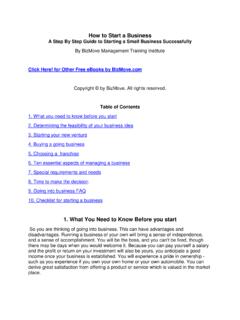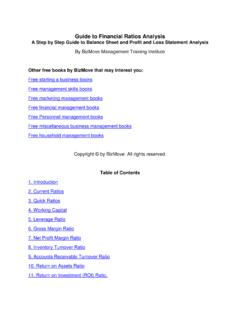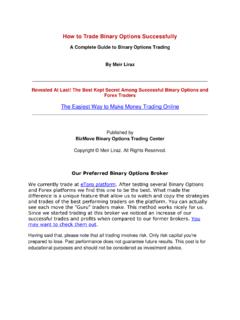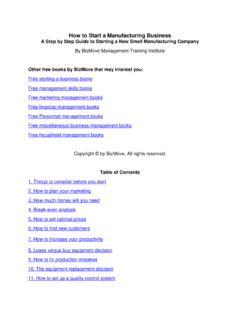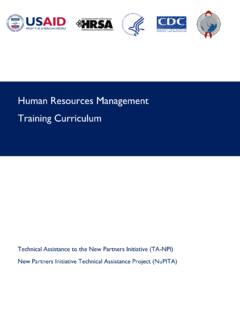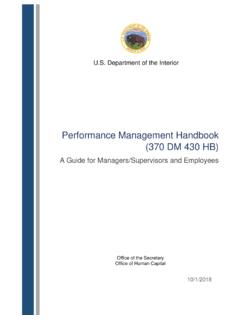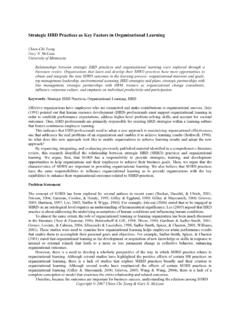Transcription of Complete Guide to Human Resource Management
1 Complete Guide to Human Resource Management By BizMove Management Training Institute Other free books by BizMove that may interest you: Free starting a business books Free Management skills books Free marketing Management books Free financial Management books Free Personnel Management books Free miscellaneous business Management books Free household Management books Copyright by BizMove. All rights reserved. Table of Contents 1. Basics of Human Resource Management 2. Developing a personnel system 3. Hiring the right employees 4.
2 employee training and development 5. Building employee trust 6. Productivity improvement 7. Delegating work and responsibility 8. Setting up a pay system 9. Importance of employee relations 10. Administrative personnel procedures 11. Effective supervisory practices 12. Positive discipline 13. Dealing with employee grievances 14. Communicating with your employees 15. Managing employee benefits 16. Developing a training program 17. Using temporary help services 1. Basics of Human Resource Management Personnel Management is concerned with the effective use of the skills of people.
3 They may be salespeople in a store, clerks in an office, operators in a factory, or technicians in a research laboratory. In a business, personnel Management starts with the recruiting and hiring of qualified people and continues with directing and encouraging their growth as they encounter problems and tensions that arise in working toward established goals. In addition to recruiting and hiring, some of the responsibilities of a personnel manager are: 1. To classify jobs and prepare wage and salary scales. 2. To counsel employees.
4 3. To deal with disciplinary problems. 4. To negotiate with labor unions and service union contracts. 5. To develop safety standards and practices. 6. To manage benefit programs, such as group insurance, health, and retirement plans. 7. To provide for periodic reviews of the performance of each individual employee , and for recognition of his or her strengths and needs for further development. 8. To assist individuals in their efforts to develop and qualify for more advanced jobs. 9. To plan and supervise training programs.
5 10. To keep abreast of developments in personnel Management . To understand the personnel manager's job think of how you would deal with the following examples of challenging employee situations: The firm's employees - especially the most qualified ones - can get comparable, if not better jobs with other employers. When a firm faces a scarcity of supervisory and specialized personnel with adequate experience and job capabilities, it has to train and develop its own people. This can be time consuming and expensive. The cost of hiring and training employees at all levels is increasing, for instance, several thousand dollars for a salesperson.
6 A mistake in hiring or in slow and inefficient methods of training can be costly. Personnel managers must comply with the law by employing, training and promoting women and persons from minority groups. The problem in doing so is that many of these employees have not had appropriate experience and education in the past. Most employees, whether or not represented by labor unions, continue to seek improvements in direct compensation, employee benefits, and working conditions. All commitments must be based upon what the firm can afford, comply with current practices of other employers, and be understood and accepted by the employee .
7 To do this, all employee policies and operating procedures should be developed and negotiated with great care. Some employees may not perform satisfactorily simply because their firm offers competitive compensation, benefits, and working conditions. In addition to these financial or physical compensations, they want responsibility, the opportunity to develop, and recognition of accomplishment in their jobs. The law have established requirements for pension and other benefit plans, and also bar mandatory retirement at age 65.
8 Complying with such changes presents real challenges. Personnel Management works to achieve practical solutions to such problems. In large firms, it generally provides support to line Management . In this staff capacity, the personnel department has the responsibility to develop and implement policies, procedures, and programs for recruitment, selection, training, placement, safety, employee benefits and services, compensation, labor relations, organization planning, and employee development. Often, the owner-manager of a firm also has to be the personnel manager.
9 In such a case it is necessary to have an overview of current trends and practices in personnel Management . All small businesses must staff their operations. This involves bringing new people into the business and making sure they are productive additions to the enterprise. Effective Human Resource Management matches and develops the abilities of job candidates and employees with the needs of the firm. A responsive personnel system will assist you in this process and is a key ingredient for growth. Human Resource Management is a balancing act.
10 At one extreme, you hire only qualified people who are well suited to the firm's needs. At the other extreme, you train and develop employees to meet the firm's needs. Most expanding small businesses fall between the two extremes , they hire the best people they can find and afford, and they also recognize the need to train and develop both current and new employees as the firm grows. One function of personnel Management deals with how to hire and train the right people and addresses the characteristics of an effective personnel system, such as: Assessing personnel needs.


